Peizheng Li
SEER-VAR: Semantic Egocentric Environment Reasoner for Vehicle Augmented Reality
Aug 24, 2025Abstract:We present SEER-VAR, a novel framework for egocentric vehicle-based augmented reality (AR) that unifies semantic decomposition, Context-Aware SLAM Branches (CASB), and LLM-driven recommendation. Unlike existing systems that assume static or single-view settings, SEER-VAR dynamically separates cabin and road scenes via depth-guided vision-language grounding. Two SLAM branches track egocentric motion in each context, while a GPT-based module generates context-aware overlays such as dashboard cues and hazard alerts. To support evaluation, we introduce EgoSLAM-Drive, a real-world dataset featuring synchronized egocentric views, 6DoF ground-truth poses, and AR annotations across diverse driving scenarios. Experiments demonstrate that SEER-VAR achieves robust spatial alignment and perceptually coherent AR rendering across varied environments. As one of the first to explore LLM-based AR recommendation in egocentric driving, we address the lack of comparable systems through structured prompting and detailed user studies. Results show that SEER-VAR enhances perceived scene understanding, overlay relevance, and driver ease, providing an effective foundation for future research in this direction. Code and dataset will be made open source.
Flying Base Stations for Offshore Wind Farm Monitoring and Control: Holistic Performance Evaluation and Optimization
Jul 10, 2025Abstract:Ensuring reliable and low-latency communication in offshore wind farms is critical for efficient monitoring and control, yet remains challenging due to the harsh environment and lack of infrastructure. This paper investigates a flying base station (FBS) approach for wide-area monitoring and control in the UK Hornsea offshore wind farm project. By leveraging mobile, flexible FBS platforms in the remote and harsh offshore environment, the proposed system offers real-time connectivity for turbines without the need for deploying permanent infrastructure at the sea. We develop a detailed and practical end-to-end latency model accounting for five key factors: flight duration, connection establishment, turbine state information upload, computational delay, and control transmission, to provide a holistic perspective often missing in prior studies. Furthermore, we combine trajectory planning, beamforming, and resource allocation into a multi-objective optimization framework for the overall latency minimization, specifically designed for large-scale offshore wind farm deployments. Simulation results verify the effectiveness of our proposed method in minimizing latency and enhancing efficiency in FBS-assisted offshore monitoring across various power levels, while consistently outperforming baseline designs.
A Heuristic-Integrated DRL Approach for Phase Optimization in Large-Scale RISs
May 07, 2025Abstract:Optimizing discrete phase shifts in large-scale reconfigurable intelligent surfaces (RISs) is challenging due to their non-convex and non-linear nature. In this letter, we propose a heuristic-integrated deep reinforcement learning (DRL) framework that (1) leverages accumulated actions over multiple steps in the double deep Q-network (DDQN) for RIS column-wise control and (2) integrates a greedy algorithm (GA) into each DRL step to refine the state via fine-grained, element-wise optimization of RIS configurations. By learning from GA-included states, the proposed approach effectively addresses RIS optimization within a small DRL action space, demonstrating its capability to optimize phase-shift configurations of large-scale RISs.
AGO: Adaptive Grounding for Open World 3D Occupancy Prediction
Apr 14, 2025Abstract:Open-world 3D semantic occupancy prediction aims to generate a voxelized 3D representation from sensor inputs while recognizing both known and unknown objects. Transferring open-vocabulary knowledge from vision-language models (VLMs) offers a promising direction but remains challenging. However, methods based on VLM-derived 2D pseudo-labels with traditional supervision are limited by a predefined label space and lack general prediction capabilities. Direct alignment with pretrained image embeddings, on the other hand, fails to achieve reliable performance due to often inconsistent image and text representations in VLMs. To address these challenges, we propose AGO, a novel 3D occupancy prediction framework with adaptive grounding to handle diverse open-world scenarios. AGO first encodes surrounding images and class prompts into 3D and text embeddings, respectively, leveraging similarity-based grounding training with 3D pseudo-labels. Additionally, a modality adapter maps 3D embeddings into a space aligned with VLM-derived image embeddings, reducing modality gaps. Experiments on Occ3D-nuScenes show that AGO improves unknown object prediction in zero-shot and few-shot transfer while achieving state-of-the-art closed-world self-supervised performance, surpassing prior methods by 4.09 mIoU.
TQD-Track: Temporal Query Denoising for 3D Multi-Object Tracking
Apr 04, 2025Abstract:Query denoising has become a standard training strategy for DETR-based detectors by addressing the slow convergence issue. Besides that, query denoising can be used to increase the diversity of training samples for modeling complex scenarios which is critical for Multi-Object Tracking (MOT), showing its potential in MOT application. Existing approaches integrate query denoising within the tracking-by-attention paradigm. However, as the denoising process only happens within the single frame, it cannot benefit the tracker to learn temporal-related information. In addition, the attention mask in query denoising prevents information exchange between denoising and object queries, limiting its potential in improving association using self-attention. To address these issues, we propose TQD-Track, which introduces Temporal Query Denoising (TQD) tailored for MOT, enabling denoising queries to carry temporal information and instance-specific feature representation. We introduce diverse noise types onto denoising queries that simulate real-world challenges in MOT. We analyze our proposed TQD for different tracking paradigms, and find out the paradigm with explicit learned data association module, e.g. tracking-by-detection or alternating detection and association, benefit from TQD by a larger margin. For these paradigms, we further design an association mask in the association module to ensure the consistent interaction between track and detection queries as during inference. Extensive experiments on the nuScenes dataset demonstrate that our approach consistently enhances different tracking methods by only changing the training process, especially the paradigms with explicit association module.
Green MLOps to Green GenOps: An Empirical Study of Energy Consumption in Discriminative and Generative AI Operations
Mar 31, 2025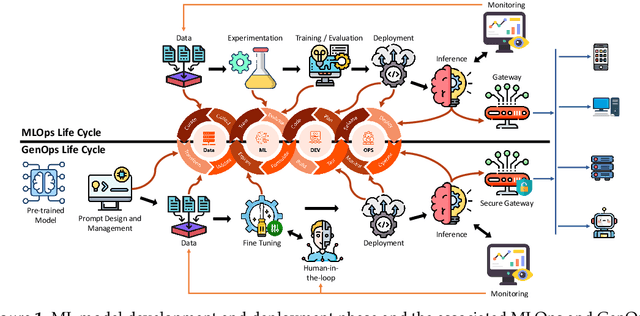


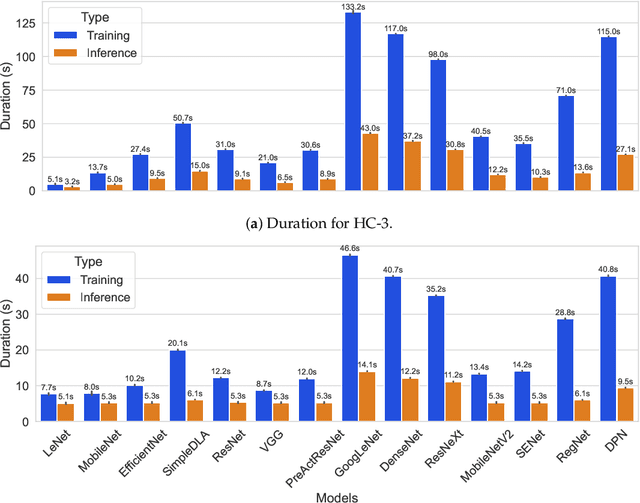
Abstract:This study presents an empirical investigation into the energy consumption of Discriminative and Generative AI models within real-world MLOps pipelines. For Discriminative models, we examine various architectures and hyperparameters during training and inference and identify energy-efficient practices. For Generative AI, Large Language Models (LLMs) are assessed, focusing primarily on energy consumption across different model sizes and varying service requests. Our study employs software-based power measurements, ensuring ease of replication across diverse configurations, models, and datasets. We analyse multiple models and hardware setups to uncover correlations among various metrics, identifying key contributors to energy consumption. The results indicate that for Discriminative models, optimising architectures, hyperparameters, and hardware can significantly reduce energy consumption without sacrificing performance. For LLMs, energy efficiency depends on balancing model size, reasoning complexity, and request-handling capacity, as larger models do not necessarily consume more energy when utilisation remains low. This analysis provides practical guidelines for designing green and sustainable ML operations, emphasising energy consumption and carbon footprint reductions while maintaining performance. This paper can serve as a benchmark for accurately estimating total energy use across different types of AI models.
Task-Oriented Connectivity for Networked Robotics with Generative AI and Semantic Communications
Mar 09, 2025Abstract:The convergence of robotics, advanced communication networks, and artificial intelligence (AI) holds the promise of transforming industries through fully automated and intelligent operations. In this work, we introduce a novel co-working framework for robots that unifies goal-oriented semantic communication (SemCom) with a Generative AI (GenAI)-agent under a semantic-aware network. SemCom prioritizes the exchange of meaningful information among robots and the network, thereby reducing overhead and latency. Meanwhile, the GenAI-agent leverages generative AI models to interpret high-level task instructions, allocate resources, and adapt to dynamic changes in both network and robotic environments. This agent-driven paradigm ushers in a new level of autonomy and intelligence, enabling complex tasks of networked robots to be conducted with minimal human intervention. We validate our approach through a multi-robot anomaly detection use-case simulation, where robots detect, compress, and transmit relevant information for classification. Simulation results confirm that SemCom significantly reduces data traffic while preserving critical semantic details, and the GenAI-agent ensures task coordination and network adaptation. This synergy provides a robust, efficient, and scalable solution for modern industrial environments.
Building the Self-Improvement Loop: Error Detection and Correction in Goal-Oriented Semantic Communications
Nov 03, 2024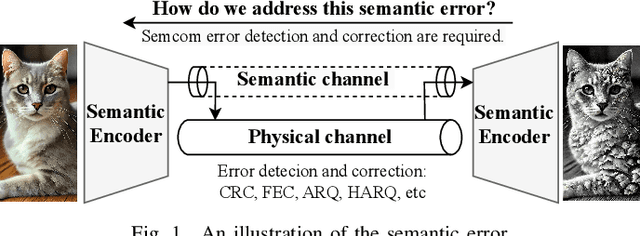
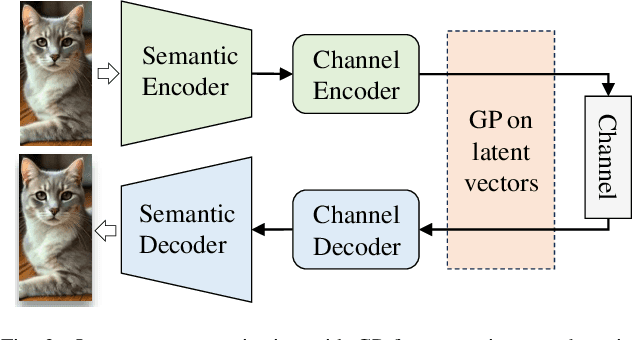
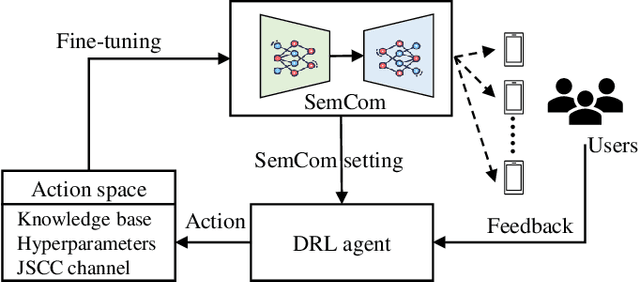

Abstract:Error detection and correction are essential for ensuring robust and reliable operation in modern communication systems, particularly in complex transmission environments. However, discussions on these topics have largely been overlooked in semantic communication (SemCom), which focuses on transmitting meaning rather than symbols, leading to significant improvements in communication efficiency. Despite these advantages, semantic errors -- stemming from discrepancies between transmitted and received meanings -- present a major challenge to system reliability. This paper addresses this gap by proposing a comprehensive framework for detecting and correcting semantic errors in SemCom systems. We formally define semantic error, detection, and correction mechanisms, and identify key sources of semantic errors. To address these challenges, we develop a Gaussian process (GP)-based method for latent space monitoring to detect errors, alongside a human-in-the-loop reinforcement learning (HITL-RL) approach to optimize semantic model configurations using user feedback. Experimental results validate the effectiveness of the proposed methods in mitigating semantic errors under various conditions, including adversarial attacks, input feature changes, physical channel variations, and user preference shifts. This work lays the foundation for more reliable and adaptive SemCom systems with robust semantic error management techniques.
From Hype to Reality: The Road Ahead of Deploying DRL in 6G Networks
Oct 30, 2024



Abstract:The industrial landscape is rapidly evolving with the advent of 6G applications, which demand massive connectivity, high computational capacity, and ultra-low latency. These requirements present new challenges, which can no longer be efficiently addressed by conventional strategies. In response, this article underscores the transformative potential of Deep Reinforcement Learning (DRL) for 6G, highlighting its advantages over classic machine learning solutions in meeting the demands of 6G. The necessity of DRL is further validated through three DRL applications in an end-to-end communication procedure, including wireless access control, baseband function placement, and network slicing coordination. However, DRL-based network management initiatives are far from mature. We extend the discussion to identify the challenges of applying DRL in practical networks and explore potential solutions along with their respective limitations. In the end, these insights are validated through a practical DRL deployment in managing network slices on the testbed.
Adapting MLOps for Diverse In-Network Intelligence in 6G Era: Challenges and Solutions
Oct 24, 2024



Abstract:Seamless integration of artificial intelligence (AI) and machine learning (ML) techniques with wireless systems is a crucial step for 6G AInization. However, such integration faces challenges in terms of model functionality and lifecycle management. ML operations (MLOps) offer a systematic approach to tackle these challenges. Existing approaches toward implementing MLOps in a centralized platform often overlook the challenges posed by diverse learning paradigms and network heterogeneity. This article provides a new approach to MLOps targeting the intricacies of future wireless networks. Considering unique aspects of the future radio access network (RAN), we formulate three operational pipelines, namely reinforcement learning operations (RLOps), federated learning operations (FedOps), and generative AI operations (GenOps). These pipelines form the foundation for seamlessly integrating various learning/inference capabilities into networks. We outline the specific challenges and proposed solutions for each operation, facilitating large-scale deployment of AI-Native 6G networks.
 Add to Chrome
Add to Chrome Add to Firefox
Add to Firefox Add to Edge
Add to Edge